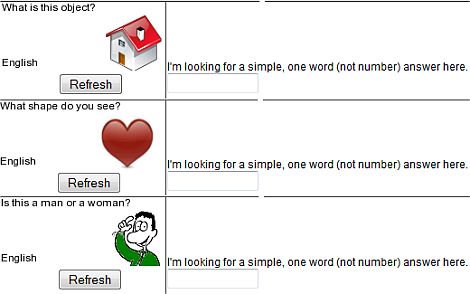Look carefully at the scene presented on the picture below: If somebody asked you a question: “Where is the coffee cup?”, you could give a simple answer: “on the mat’. But you could also say “to the left of the lamp” as well as “on the table”. All those answers are correct, although they require several subjective and nuanced judgements which we - humans - do intuitively. What about chatbots?
We all have heard about Loebner Prize or Chatterbox Challenge contests. The idea behind them is to emerge the chatbot that proves to be as conversationally intelligent as humans. Now we have an additional factor imitating human perception: visual skills.
According to enhanced Turing test, chatterbots have to be able to describe size of “seen” objects, their position relative to each other, and their relevance in a particular situation. They have to perceive three-dimensional scenes in a human-like way, if they want to be considered truly intelligent.
 This issue is closely related to Captcha images, which are also about automated visual recognition. As you might know CAPTCHA stands for “Completely Automated Public Turing test to tell Computers and Humans Apart”. Captcha images allow people to gain acces to certain areas of a web page such as registering forms or posting a comment on a forum. They are supposed to act as a sort of “Gatekeeper” differentiating between human users and automated software. Unfortunately, most Captcha scripts are easily hacked by spam bots which bypass captcha’s protection using a character recognition software.
This issue is closely related to Captcha images, which are also about automated visual recognition. As you might know CAPTCHA stands for “Completely Automated Public Turing test to tell Computers and Humans Apart”. Captcha images allow people to gain acces to certain areas of a web page such as registering forms or posting a comment on a forum. They are supposed to act as a sort of “Gatekeeper” differentiating between human users and automated software. Unfortunately, most Captcha scripts are easily hacked by spam bots which bypass captcha’s protection using a character recognition software.
One of Chatbots.org experts, David Morton, suggests to stop using those hard to read groups of obscured, deformed letters. On dedicated Captcha4us website he presents an innovative solution for intelligent human verification: display a randomly generated image, and then require one word answer to a question about that image. Such captchas constitute a kind of intelligence games, as you can see some examples below.

Whether it is automatic or not, today’s applications are surely able to mimic some of human abilities and to exhibit similar visual intelligence. Speaking of human perception - would you like to check, whether a Loebner’s judge would distinguish you from the software? Please, feel free to take the visual Turing test prepared by Celeste Biever and Richard Fisher. It’s funny and yet - very instructive!




Comments
There are 2 comments: